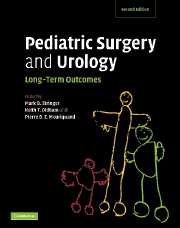Book contents
- Frontmatter
- Contents
- List of contributors
- Acknowledgments
- Preface
- Part I General issues
- Part II Head and neck
- Part III Thorax
- Part IV Abdomen
- Part V Urology
- 41 Introduction
- 42 Upper tract dilation
- 43 Posterior urethral valves
- 44 Vesicoureteric reflux
- 45 Genitoplasty in exstrophy and epispadias
- 46 Feminization (surgical aspects)
- 47 Hypospadias
- 48 Bladder exstrophy
- 49 Surgery for neuropathic bladder and incontinence
- 50 Non-neuropathic bladder–sphincter dysfunction
- 51 Undescended testes
- 52 Circumcision
- 53 The single kidney
- 54 Multicystic kidney
- 55 Urolithiasis
- 56 Gonadal tumors
- Part VI Oncology
- Part VII Transplantation
- Part VIII Trauma
- Part IX Miscellaneous
- Index
- Plate section
- References
45 - Genitoplasty in exstrophy and epispadias
from Part V - Urology
Published online by Cambridge University Press: 08 January 2010
- Frontmatter
- Contents
- List of contributors
- Acknowledgments
- Preface
- Part I General issues
- Part II Head and neck
- Part III Thorax
- Part IV Abdomen
- Part V Urology
- 41 Introduction
- 42 Upper tract dilation
- 43 Posterior urethral valves
- 44 Vesicoureteric reflux
- 45 Genitoplasty in exstrophy and epispadias
- 46 Feminization (surgical aspects)
- 47 Hypospadias
- 48 Bladder exstrophy
- 49 Surgery for neuropathic bladder and incontinence
- 50 Non-neuropathic bladder–sphincter dysfunction
- 51 Undescended testes
- 52 Circumcision
- 53 The single kidney
- 54 Multicystic kidney
- 55 Urolithiasis
- 56 Gonadal tumors
- Part VI Oncology
- Part VII Transplantation
- Part VIII Trauma
- Part IX Miscellaneous
- Index
- Plate section
- References
Summary
There is a spectrum of congenital anomalies of the lower urinary tract and pelvis covered by the term “exstrophy/epispadias.” At the worst end is cloacal exstrophy and at the most minor end is an epispadiac position of an otherwise normal urethra (Fig. 45.1). In males and females with an incompletely closed pubic ring the genitalia have a characteristic deformity called epispadias. The reconstruction of this anomaly is the same, regardless of the degree of bladder anomaly, although, especially in males, the system of bladder emptying may influence the surgical decisions. The extent of surgery required depends on the functional consequences of the deformity. Although chordee correction is commonly performed as a part of the reconstruction in infancy, further surgery after puberty is often needed to allow intercourse to take place.
Exstrophy is not, on its own, a lethal condition. The surgery and subsequent complications may be. In 1926 Dr. Charles Mayo, cofounder of the Clinic, published a paper on his experience of 66 cases of exstrophy. He recorded that 72% were still alive but he was not optimistic that the long-term results would be good, as most were still under 10 years old. Historically, 67% of patients would be dead by the age of 20, though his oldest survivor was 73. It was not until after the Second World War that a combination of therapeutic advances conferred a more normal lifespan on exstrophy patients.
- Type
- Chapter
- Information
- Pediatric Surgery and UrologyLong-Term Outcomes, pp. 583 - 594Publisher: Cambridge University PressPrint publication year: 2006

